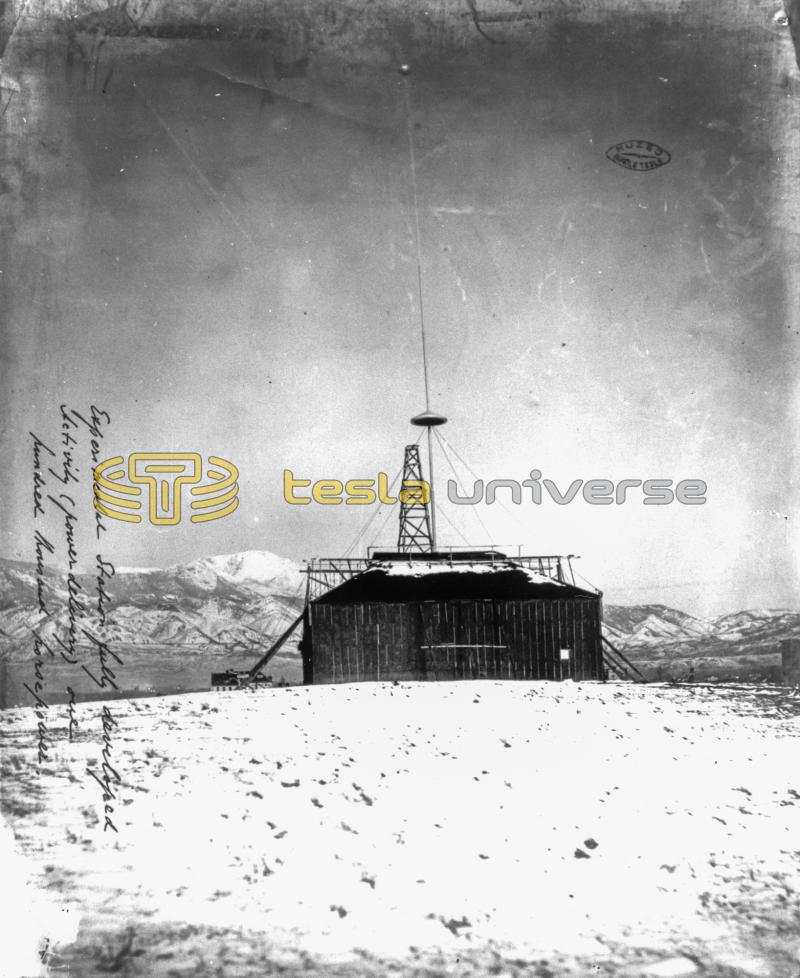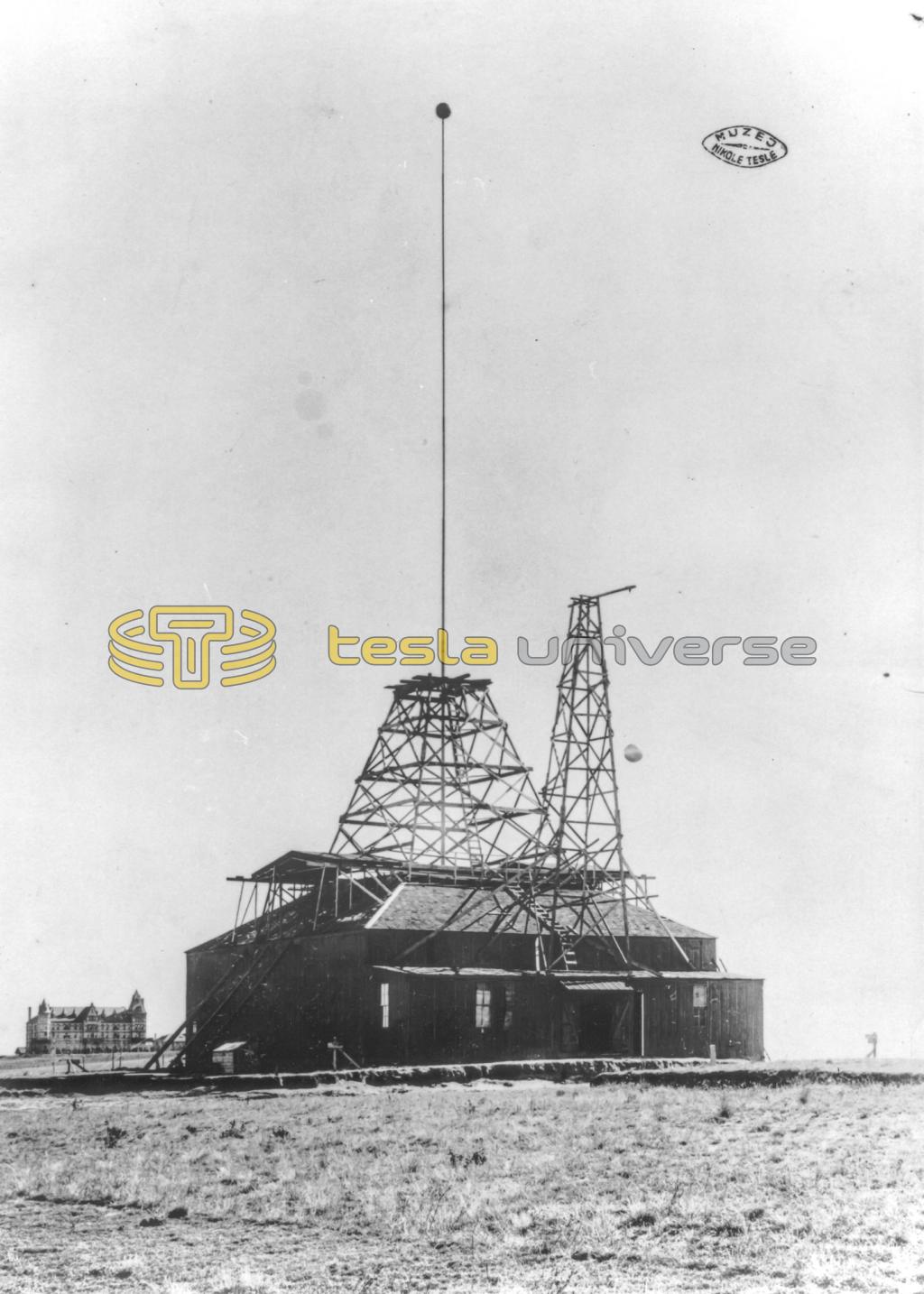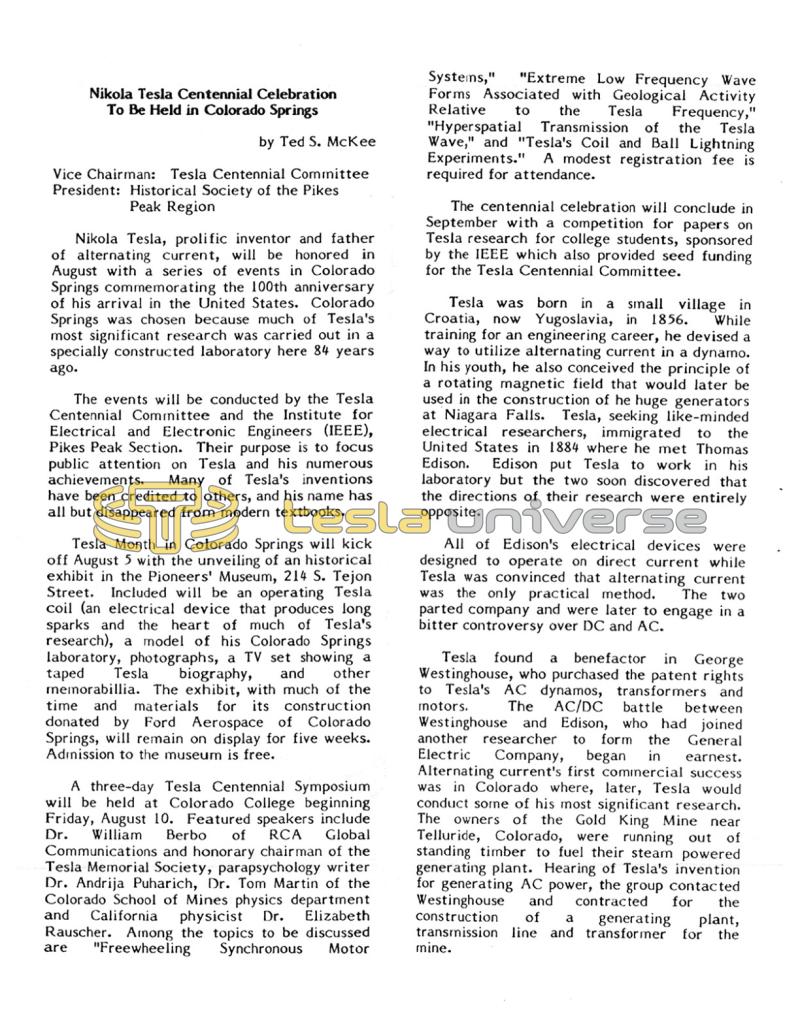
Nikola Tesla Articles
Nikola Tesla Centennial Celebration To Be Held in Colorado Springs
by Ted S. McKee
Vice Chairman: Tesla Centennial Committee
President: Historical Society of the Pikes Peak Region
Nikola Tesla, prolific inventor and father of alternating current, will be honored in August with a series of events in Colorado Springs commemorating the 100th anniversary of his arrival in the United States. Colorado Springs was chosen because much of Tesla's most significant research was carried out in a specially constructed laboratory here 84 years ago.
The events will be conducted by the Tesla Centennial Committee and the Institute for Electrical and Electronic Engineers (IEEE), Pikes Peak Section. Their purpose is to focus public attention on Tesla and his numerous achievements. Many of Tesla's inventions have been credited to others, and his name has all but disappeared from modern textbooks.
Tesla Month in Colorado Springs will kick off August 5 with the unveiling of an historical exhibit in the Pioneers' Museum, 214 S. Tejon Street. Included will be an operating Tesla coil (an electrical device that produces long sparks and the heart of much of Tesla's research), a model of his Colorado Springs laboratory, photographs, a TV set showing a taped Tesla biography, and other memorabillia. The exhibit, with much of the time and materials for its construction donated by Ford Aerospace of Colorado Springs, will remain on display for five weeks. Admission to the museum is free.
A three-day Tesla Centennial Symposium will be held at Colorado College beginning Friday, August 10. Featured speakers include Dr. William Berbo of RCA Global Communications and honorary chairman of the Tesla Memorial Society, parapsychology writer Dr. Andrija Puharich, Dr. Tom Martin of the Colorado School of Mines physics department and California physicist Dr. Elizabeth Rauscher. Among the topics to be discussed are "Freewheeling Synchronous Motor Systems," "Extreme Low Frequency Wave Forms Associated with Geological Activity Relative to the Tesla Frequency," "Hyperspatial Transmission of the Tesla Wave," and "Tesla's Coil and Ball Lightning Experiments." A modest registration fee is required for attendance.
The centennial celebration will conclude in September with a competition for papers on Tesla research for college students, sponsored by the IEEE which also provided seed funding for the Tesla Centennial Committee.
Tesla was born in a small village in Croatia, now Yugoslavia, in 1856. While training for an engineering career, he devised a way to utilize alternating current in a dynamo. In his youth, he also conceived the principle of a rotating magnetic field that would later be used in the construction of he huge generators at Niagara Falls. Tesla, seeking like-minded electrical researchers, immigrated to the United States in 1884 where he met Thomas Edison. Edison put Tesla to work in his laboratory but the two soon discovered that the directions of their research were entirely opposite.
All of Edison's electrical devices were designed to operate on direct current while Tesla was convinced that alternating current was the only practical method. The two parted company and were later to engage in a bitter controversy over DC and AC.
Tesla found a benefactor in George Westinghouse, who purchased the patent rights to Tesla's AC dynamos, transformers and motors. The AC/DC battle between Westinghouse and Edison, who had joined another researcher to form the General Electric Company, began in earnest. Alternating current's first commercial success was in Colorado where, later, Tesla would conduct some of his most significant research. The owners of the Gold King Mine near Telluride, Colorado, were running out of standing timber to fuel their steam powered generating plant. Hearing of Tesla's invention for generating AC power, the group contacted Westinghouse and contracted for the construction of a generating plant, transmission line and transformer for the mine.
Westinghouse, recognizing the importance of such a projet to the success of AC, contributed $25,000 for construction. A hydroelectric plant was built on a river 2 1/2 miles from the mine, a Tesla generator was installed, transmission lines were strung, and a transformer and power plant were installed at the mine. The project was a resounding success and in 1891 the Gold King Mine became the first user in the world of alternating current transmitted at high voltage over a long distance.
Westinghouse and his forces won a significant and final victory when, as a result of the Colorado project, his company was awarded a contract to supply power and lighting for the World Columbian Exposition in Chicago in 1883. Later, Westinghouse was named supplier to install the first AC power generating machinery, all carrying Tesla patents, at Niagara Falls. Power flowed from the falls to Buffalo in 1896 and, with this achievement, AC was accepted as the established method for generating and transmitting electrical current. Edison and General Electric were defeated.
During the following years, Tesla experimented with the wireless transmission of electrical power through the earth itself, what he called "shadowgraph pictures" (forerunner of X-rays), and a carbon button lamp that contained the principles of today's atom smashers.
By 1899, he was outgrowing his New York City laboratory. He not only needed more room, he needed privacy. One of the Westinghouse patent attorneys had come to Colorado Springs for his health, maintaining a steady flow of correspondence with Tesla. It was he who suggested that Tesla travel west to gain the freedom he needed. The attorney also arranged for power from the Colorado Springs Electric Company and obtained land for the laboratory. Tesla took to the suggestion immediately, particularly because he would be able to carry out his experiments in clear air at relatively high altitudes. Tesla needed funding and he approached John Jacob Astor Astor, a friend of long standing. contributed $30,000, another friend added $10,000 and Tesla was on his way to Colorado Springs.
He arrived here on May 17, 1899, where he built his laboratory on the eastern fringe of town a few blocks east of the School for the Deaf and Blind. The lab was 100 feet on a side, built of wood. Inside was a 75 foot diameter air core transformer with a 10 foot secondary coil. Through the roof rose an 80 foot wooden tower, to which was attached an 120 foot mast topped by a 3 foot copper ball. During his stay here, he produced man-made lightning flashes from the copper ball that measured 135 feet in length. During the production of one such lightning array, Tesla used so much power, about 100 million volts, that he blew out the electric company's generator, plunging the entire city into darkness. Within a few days he had repaired the generator, restored himself to the good graces of the utility and again was provided free power. Thunder created by the huge was heard all the way to lightning bolts Cripple Creek.
While in Colorado Springs, Tesla demonstrated that the earth itself could be used as a giant conductor for the transmission of power and messages. He lived at the Alta Vista Hotel on south Cascade Avenue, now demolished, and commuted to his laboratory on the Antlers Hotel livery.
The money finally ran out and Tesla was forced to return to New York in January 1900. He secured financing from J. Pierpoint Morgan for the construction of a huge wireless broadcasting tower on Long Island from which he planned to provide world-wide communications, including messages, pictures, weather warnings and stock market reports. Financial and labor problems coupled with the withdrawal of support by Morgan doomed the project and the facility was never completed.
Tesla shifted his research to turbines and other projects but a continuing lack of funds prevented him from bringing most of them to reality. His notebooks, crammed with figures, diagrams and countless theories, are still read today by engineers and physicists who continue research using Tesla's findings and ideas.
Among other developments for which Tesla credited are the induction motor, fluorescent lighting, plans for an early flying is machine, the power of electrical resonance, and a toy boat guided by wireless remote control which he demonstrated at Madison Square Garden in 1898. The basics of his remote control today are the heart of missle guidance systems.
Tesla died in New York City on January 7, 1943. Hundreds of people attended his funeral services at the Cathedral of St. John the Divine where three Nobel prize winners paid tribute to "one of the outstanding intellects of the world who paved the way for many of the technological developments of modern times."


